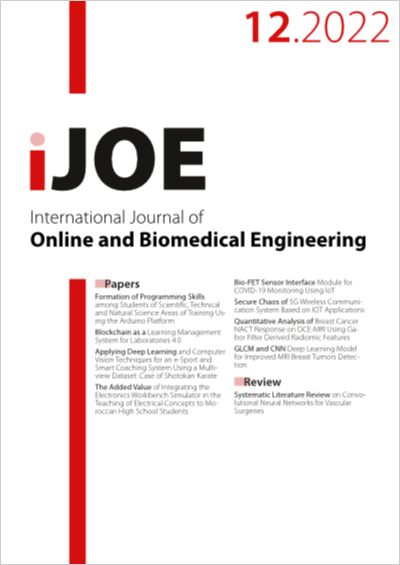Quantitative Analysis of Breast Cancer NACT Response on DCE-MRI Using Gabor Filter Derived Radiomic Features
DOI:
https://doi.org/10.3991/ijoe.v18i12.32501Keywords:
Breast cancer, DCE-MRI, Gabor filter bank, Neoadjuvant chemotherapy, Radiomic features, Treatment responseAbstract
In this work, an attempt has been made to quantify the treatment response due to Neoadjuvant Chemotherapy (NACT) on the publicly available QIN-Breast of TCIA database (N = 25) using Gabor filter derived radiomic features. The Gabor filter bank is constructed using 5 different scales and 7 different orientations. Different radiomic features were extracted from Gabor filtered Dynamic Contrast Enhanced Magnetic Resonance images (DCE-MRI) of patients having 3 different visits (Visit 1: before, Visit 2: after 1st cycle, and Visit 3: the last cycle of NACT). The extracted radiomic features were analyzed statistically and Area Under Receiver Operating Characteristic (AUROC) has been calculated. Results show that the Gabor derived radiomic features could differentiate the pathological differences among all three visits. Energy has shown a significant difference between all the three orientations particularly between Visits 2 & 3. However, Entropy from λ=2 and θ=300 between Visit 2 & 3, Skewness from λ=2 and θ=1200 between Visit 1 & 3 could differentiate the treatment response with high statistical significance of p=0.006 and 0.001 respectively. From the ROC analysis, the better predictors were Short Run Emphasis (SRE), Short Zone Emphasis (SZE), and Energy between Visit 1 & 3 by achieving an AUROC of 76.38%, 75.16%, and 71.10% respectively. Further, the results suggest that the radiomic features are capable of quantitatively compare the breast NACT prognosis that varies across multi-oriented Gabor filters.
Downloads
Published
How to Cite
Issue
Section
License
Copyright (c) 2022 Priscilla Dinkar Moyya, Mythili Asaithambi

This work is licensed under a Creative Commons Attribution 4.0 International License.



